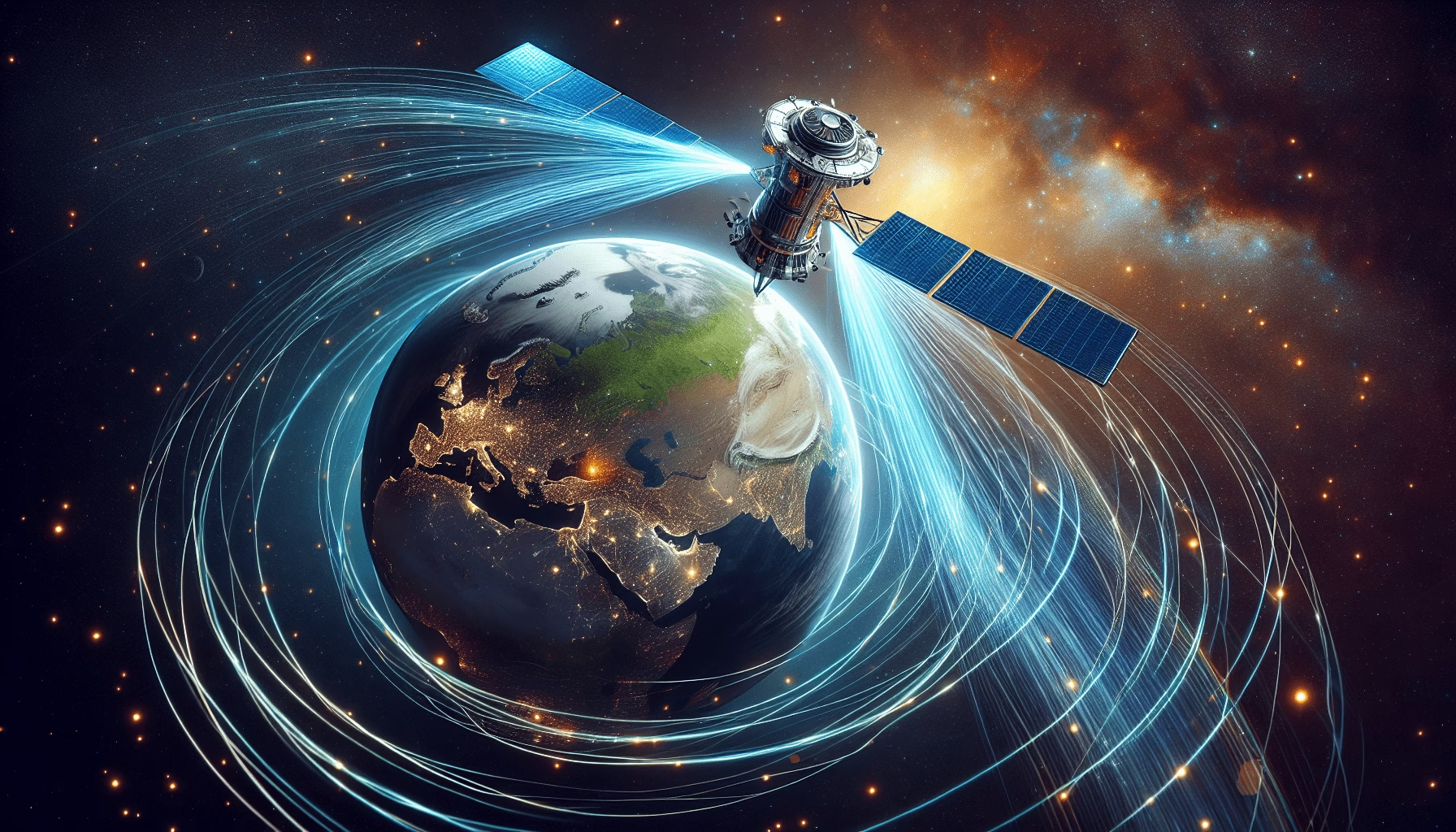Have you ever wondered how the vastness of space could transform our digital connectivity across the solar system? As we stand on the precipice of a new frontier in communication, the idea of a “Space Internet” capturing our imagination is no longer just science fiction, but a rapidly approaching reality. The concept revolves around creating an interconnected web that extends beyond Earth, enabling seamless communication throughout our solar system.

Table of Contents
Historical Context: From Science Fiction to Reality
The notion of a globally encompassing internet that extends into space has fascinated scientists and science fiction enthusiasts alike for decades. The initial dreams of such a system were propelled by the need for reliable and fast communication between Earth and space expeditions. Projects like ARPANET laid initial groundwork for what would become the Internet today, but extending this to space presents its own unique set of challenges.
Early Developments and Influences
Back in the 1960s, space exploration was a competition spurred by the Cold War. The primary aim was to send humans into space, not to establish a communication network. However, as our ambitions grew, so did the need for robust communication channels. The theoretical underpinnings of a space communication network can be traced back to these early days when simple radio transmissions were cutting-edge technology.
Transformation through Technology
As time progressed, technology advancements have opened up possibilities that were once relegated to the domain of science fiction. The emergence of satellite technology was a key turning point. In recent years, private companies and government space agencies have explored possibilities for establishing a space internet. Projects like SpaceX’s Starlink are pioneering efforts to blanket Earth in satellite internet coverage, a potential stepping stone for broader solar system connectivity.
Key Concepts Behind Space Internet
The idea of a Space Internet may seem like a futuristic concept, but it is grounded in several key principles that make it feasible. The very foundation is about enabling fast and efficient data transmission across vast distances.
Infrastructure: Satellites and Beyond
To achieve continuous connectivity, a network of satellites is required. These satellites must be positioned strategically to relay signals across vast distances, similar to the network of cell towers on Earth. Geosynchronous satellites, low Earth orbit satellites, and even lunar and planetary relay stations will play crucial roles in this expansive network.
Overcoming the Challenges
The challenges of creating a Space Internet are manifold. These include dealing with the delay caused by light-speed limitations, interference from cosmic radiation, minor glitches in signal transmission due to space debris, and the massive cost of launching the infrastructure into space. Technical expertise and innovation are essential in overcoming these hurdles.

The Roadmap: Steps Toward Interplanetary Communication
Laying the groundwork for a Space Internet requires coordinated international efforts. Here are some of the planned phases:
Step 1: Expanding Satellite Coverage on Earth
The first step involves expanding satellite internet coverage on Earth. Projects like Starlink aim to achieve this goal, offering global coverage. While these networks initially focus on Earth, the technologies developed will be crucial to future space-based applications.
Step 2: Creating a Lunar Internet
The moon serves as the most immediate target for establishing an extraterrestrial internet. By deploying lunar relay stations, we can ensure efficient communication between Earth and the moon, which will be essential for future lunar bases and expeditions.
Step 3: Mars and Beyond
The more ambitious goal is to extend connectivity to other planets. Mars, being our next target for human settlement, requires a dedicated communication network. Establishing a network on Mars involves deploying satellites and ground stations that facilitate real-time communication with Earth.
The Impact on Space Missions and Everyday Life
By implementing a Space Internet, the implications for both space missions and everyday life are profound. For space explorations, it means faster and more reliable communication, facilitating scientific discoveries and enabling human exploration. For people on Earth, access to real-time data from space can unlock unprecedented educational opportunities and drive innovation.
Enhancing Scientific Research
With a robust communication network, data collected from space missions can be transmitted swiftly back to Earth, enriching our understanding of the universe. The real-time transfer of high-resolution imagery, atmospheric data, and geological information will revolutionize space research.
Making Space More Accessible
By diminishing communication barriers, space travel becomes more viable and appealing. Future space tourists, researchers, and scientists will benefit from constant connectivity, ensuring that information exchange during missions is as seamless as possible.

Visualizing the Concept: A Practical Playbook
To paint a clearer picture of how a Space Internet might function, one can consider a few real-world analogies and practical insights:
Smart Satellite Arrays
Imagine a network on Earth seamlessly lined with an array of satellites distributed strategically across the solar system. These operate like a mesh network, ensuring there are no blind spots and allowing data to flow freely.
Real-Time Streaming from Mars
Consider how powerful it would be to stream live videos directly from a rover on Mars, or even a future Mars habitat. Research teams on Earth could collaborate with astronauts in real-time, a scenario made possible through robust interplanetary connectivity.
Case Studies and Success Stories: Paving the Way Forward
Several initiatives are already paving the way for the future implementation of the Space Internet. Let’s explore some notable examples:
Starlink: Pioneering Satellite Internet
SpaceX’s Starlink has made significant strides in establishing comprehensive satellite internet coverage across Earth. While focusing on Earth, the technology and methods can serve as a model for expanding internet across our solar system.
NASA’s Lunar Laser Communication Demonstration (LLCD)
NASA’s Lunar Laser Communication Demonstration is an excellent example of high-speed, high-data-rate communication technologies being tested. By employing lasers, data is transmitted across long distances with minimal loss, showcasing potential methods for future interplanetary networks.

The Challenges Ahead: Prepping for Cosmic Connectivity
While the potential is enormous, several challenges remain that must be addressed to make the Space Internet a reality. Here are a few key concerns and potential solutions:
Technical Hurdles
The massive distances in space create latency and require innovative engineering solutions. Developing new antennas that minimize signal loss and creating software to manage these networks efficiently are crucial.
Legal and Regulatory Challenges
Space, a domain that extends beyond national boundaries, requires international cooperation. Establishing policies for satellite placement, frequency usage, and more is essential to prevent territorial conflicts and promote sustainable development.
Sustainability and Space Debris
Finally, ensuring that the space environment remains safe and sustainable is a concern. The increase in satellite launches could lead to space debris, posing risks to both existing satellites and future missions. Comprehensive planning to address this aspect is imperative.
A Glimpse into the Future: What the Space Internet Promises
The vision of a Space Internet is poised to change the course of both space exploration and terrestrial life. As technology advances and the infrastructure unfolds, expect a future where seamless communication—regardless of distance—makes the solar system feel smaller and more accessible.
By breaking down barriers, this interconnected web can inspire the next generation of explorers, scientists, and global citizens to reach beyond the skies, unlocking new possibilities along the way.
The Space Internet, a futuristic yet tangible aim, promises to reshape our understanding of connectivity and the universe around us. As we stand on the cusp of this new era, it’s imperative to embrace both the challenges and the vast potential this endeavor holds.


